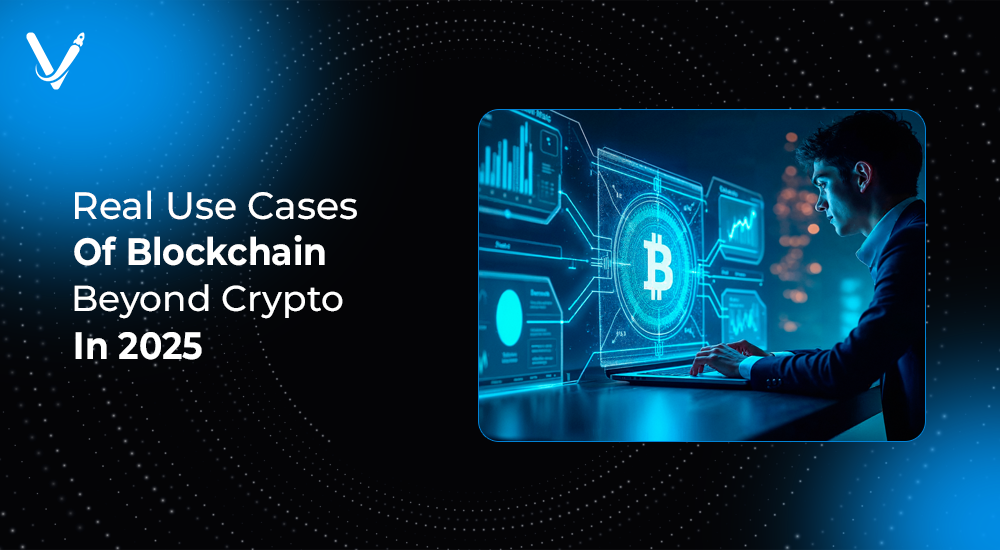Real Use Cases of Blockchain Beyond Crypto in 2025


- Jun 10, 2025
Blockchain was once synonymous with cryptocurrency. For years, its role was largely limited to powering digital currencies like Bitcoin and Ethereum. Fast forward to 2025, and the landscape has changed dramatically. Today, blockchain is recognized as a foundational technology, transforming industries far beyond financial speculation.
Across healthcare, logistics, digital identity, intellectual property, and even voting systems, blockchain is proving its value in solving complex problems with transparency, security, and decentralization.
This article explores the most impactful, practical, and scalable real use cases of blockchain beyond crypto in 2025. We’ll examine how enterprises, governments, and startups are deploying blockchain solutions to improve operations, build trust, and innovate at scale.
In 2025, the global digital economy demands higher levels of trust, security, and automation. Blockchain answers that call with a combination of decentralization, immutability, and smart contract functionality.
Key advantages of blockchain:
As industries shift towards digital-first models, blockchain is no longer an experimental concept—it’s becoming infrastructure.
Supply chains are complex ecosystems involving manufacturers, suppliers, logistics partners, and retailers. Traditional systems struggle with visibility, fraud prevention, and data silos. Blockchain offers a transparent, tamper-proof ledger of every step in the supply chain.
IBM’s blockchain platform helps companies like Nestlé and Walmart track food from farm to shelf. When a food safety issue arises, contaminated products can be traced in seconds rather than days, reducing risk and waste.
Healthcare has long battled with fragmented systems, data breaches, and inefficiencies. Blockchain is revolutionizing the sector by creating secure, interoperable health records that empower patients and providers.
Platforms like Medicalchain give patients ownership of their medical records, which can be securely shared with physicians across borders. Guardtime’s blockchain secures the health records of over a million Estonians, enhancing trust and availability.
In an age of rising digital fraud and privacy concerns, traditional identity systems are no longer sufficient. Blockchain enables self-sovereign identity (SSI) models, where individuals control their data instead of central authorities.
ID2020 is a global initiative that uses blockchain to provide digital identities for the underserved. Microsoft’s ION project, built on Bitcoin’s blockchain, allows users to manage decentralized identifiers (DIDs) across platforms.
Even though this category originates within crypto, DeFi has expanded to include mainstream financial services—such as lending, insurance, and asset management—without relying on banks or brokers.
DeFi platforms offer liquidity pools where users lend or borrow assets through automated smart contracts. Newer systems tokenize invoices or real estate, unlocking capital for small businesses globally.
Creators struggle to prove ownership and monetize content in a digital-first world. Blockchain helps by creating time-stamped, immutable records of intellectual property and licensing terms.
Audius uses blockchain to pay musicians directly, cutting out intermediaries. Artists can mint NFTs tied to music, artwork, or written work with embedded royalties.
Real estate transactions are slow, expensive, and paperwork-heavy. Blockchain reduces friction by enabling tokenization of properties and execution of smart contracts for buying, renting, or leasing.
Propy facilitates blockchain-based real estate deals that are recorded on public ledgers. RealT tokenizes rental properties in the U.S., allowing global users to earn rental income fractionally.
Elections are vulnerable to manipulation, hacking, and mistrust. Blockchain offers verifiable, transparent voting systems where each vote is recorded immutably and anonymously.
Voatz enables blockchain-based mobile voting for overseas citizens and military personnel. Horizon State piloted community voting systems in New Zealand with success.
Verifying academic records and certifications is often slow and manual. Blockchain makes digital credentials easy to verify, tamper-proof, and portable.
MIT issues diplomas on the blockchain, allowing graduates to share verifiable, scannable credentials with employers anywhere in the world.
As sustainability becomes a global priority, blockchain plays a role in energy trading, grid decentralization, and emissions tracking.
These platforms allow peer-to-peer energy trading on microgrids. Users can buy and sell excess solar power using blockchain-based tokens.
Brands are adopting blockchain to build trust and loyalty through transparent supply chains, digital coupons, and decentralized marketplaces.
Starbucks uses blockchain to trace coffee beans from origin to cup. Lolli rewards online shoppers with Bitcoin-backed incentives.
Despite the momentum, blockchain adoption faces obstacles. Understanding these issues helps plan resilient, effective implementations.
Scalability: Public blockchains can slow under load
Regulatory uncertainty: Laws vary widely across regions
Interoperability gaps: Many blockchains can't communicate with each other
User onboarding: Wallets, keys, and tokens confuse new users
Environmental concerns: Proof-of-work models consume energy (though shifting to PoS)
Solutions include using layer 2 protocols, hybrid chains, and educational UX design.
The next frontier of blockchain lies in mass adoption, zero-knowledge proofs, and interconnected ecosystems. Platforms are evolving toward privacy-preserving solutions, faster consensus mechanisms, and AI-driven smart contracts.
Expect tighter integration with IoT, real-time compliance, and vertical-specific blockchains. By 2030, most industries will treat blockchain not as an add-on, but as standard infrastructure.
Blockchain’s potential has only begun to be realized. What started as a ledger for Bitcoin has become a catalyst for digital trust, automation, and decentralization across sectors.
At Vasundhara Infotech, we help businesses build blockchain-powered solutions that drive transparency, security, and efficiency—no matter the industry. If you're ready to explore how blockchain can revolutionize your business model, let's connect.
Copyright © 2025 Vasundhara Infotech. All Rights Reserved.
